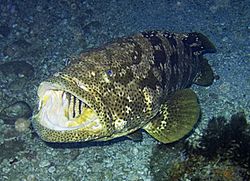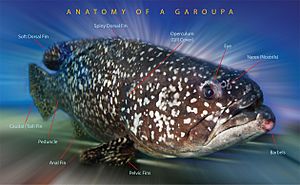Grouper facts for kids
Quick facts for kids Groupers |
|
|---|---|
 |
|
| Malabar grouper, Epinephelus malabaricus | |
| Scientific classification | |
| Kingdom: | |
| Phylum: | |
| Class: | |
| Order: | |
| Family: | |
| Subfamily: |
Epinephelinae
|
Groupers are big, strong fish that live in the ocean. They are a type of fish related to perch and sea basses. You can find many different kinds of groupers. Most of them belong to two main groups called Epinephelus and Mycteroperca.
There are also other smaller groups of fish that are called groupers. For example, fish in the group Plectropomus are known as coralgroupers. All these fish are part of a larger family called Epinephelinae.
About Groupers
Groupers are a type of bony fish. They usually have a strong body and a very large mouth. These fish are not made for swimming fast or for long distances.
Some groupers can grow very large. They can be over a meter long and weigh up to 100 kilograms (about 220 pounds)! But remember, there are many different kinds of groupers, so their sizes can change a lot.
How Groupers Eat
Groupers swallow their food whole instead of biting off pieces. They don't have many teeth on the edges of their jaws. Instead, they have strong, crushing teeth deep inside their throat.
They often eat other fish, octopuses, and crabs or shrimp. Some groupers like to hide and surprise their prey. Others are more active hunters. There are stories about the largest groupers, like the giant grouper, attacking humans. However, these stories have not been proven true.
Amazing Mouths
A grouper's mouth and gills work together like a powerful vacuum cleaner! This system helps them suck their prey right into their mouths from a distance.
They also use their mouths to dig into the sand. They can make shelters under big rocks by blowing sand out through their gills.
Hunting Buddies
Did you know that some groupers work together to hunt? Scientists have seen roving coralgroupers sometimes team up with giant moray eels to catch food. It's like they are hunting partners!
Images for kids
-
A tiny monogenean parasite that lives on the gills of a grouper.
-
Gulai kerapu, a tasty Padang food made with grouper.
See also
 In Spanish: Mero para niños
In Spanish: Mero para niños




